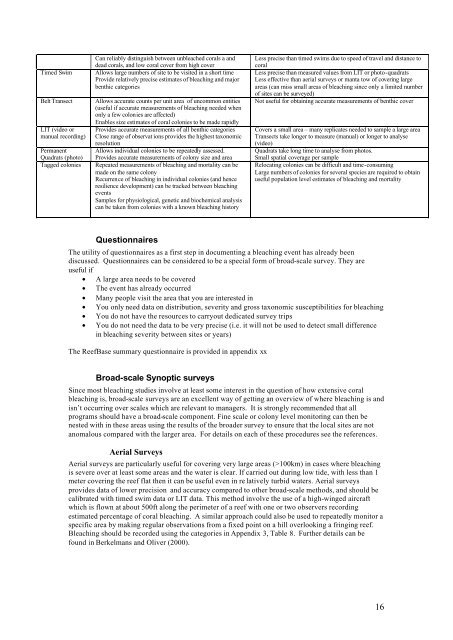Oliver et al (2004) Monitoring bleaching
Oliver et al (2004) Monitoring bleaching.pdf
Oliver et al (2004) Monitoring bleaching.pdf
You also want an ePaper? Increase the reach of your titles
YUMPU automatically turns print PDFs into web optimized ePapers that Google loves.
Timed Swim<br />
Belt Transect<br />
LIT (video or<br />
manu<strong>al</strong> recording)<br />
Permanent<br />
Quadrats (photo)<br />
Tagged colonies<br />
Can reliably distinguish b<strong>et</strong>ween unbleached cor<strong>al</strong>s a and<br />
dead cor<strong>al</strong>s, and low cor<strong>al</strong> cover from high cover<br />
Allows large numbers of site to be visited in a short time<br />
Provide relatively precise estimates of <strong>bleaching</strong> and major<br />
benthic categories<br />
Allows accurate counts per unit area of uncommon entities<br />
(useful if accurate measurements of <strong>bleaching</strong> needed when<br />
only a few colonies are affected)<br />
Enables size estimates of cor<strong>al</strong> colonies to be made rapidly<br />
Provides accurate measurements of <strong>al</strong>l benthic categories<br />
Close range of observat ions provides the highest taxonomic<br />
resolution<br />
Allows individu<strong>al</strong> colonies to be repeatedly assessed.<br />
Provides accurate measurements of colony size and area<br />
Repeated measurements of <strong>bleaching</strong> and mort<strong>al</strong>ity can be<br />
made on the same colony<br />
Recurrence of <strong>bleaching</strong> in individu<strong>al</strong> colonies (and hence<br />
resilience development) can be tracked b<strong>et</strong>ween <strong>bleaching</strong><br />
events<br />
Samples for physiologic<strong>al</strong>, gen<strong>et</strong>ic and biochemic<strong>al</strong> an<strong>al</strong>ysis<br />
can be taken from colonies with a known <strong>bleaching</strong> history<br />
Less precise than timed swims due to speed of travel and distance to<br />
cor<strong>al</strong><br />
Less precise than measured v<strong>al</strong>ues from LIT or photo-quadrats<br />
Less effective than aeri<strong>al</strong> surveys or manta tow of covering large<br />
areas (can miss sm<strong>al</strong>l areas of <strong>bleaching</strong> since only a limited number<br />
of sites can be surveyed)<br />
Not useful for obtaining accurate measurements of benthic cover<br />
Covers a sm<strong>al</strong>l area – many replicates needed to sample a large area<br />
Transects take longer to measure (manu<strong>al</strong>) or longer to an<strong>al</strong>yse<br />
(video)<br />
Quadrats take long time to an<strong>al</strong>yse from photos.<br />
Sm<strong>al</strong>l spati<strong>al</strong> coverage per sample<br />
Relocating colonies can be difficult and time-consuming<br />
Large numbers of colonies for sever<strong>al</strong> species are required to obtain<br />
useful population level estimates of <strong>bleaching</strong> and mort<strong>al</strong>ity<br />
Questionnaires<br />
The utility of questionnaires as a first step in documenting a <strong>bleaching</strong> event has <strong>al</strong>ready been<br />
discussed. Questionnaires can be considered to be a speci<strong>al</strong> form of broad-sc<strong>al</strong>e survey. They are<br />
useful if<br />
• A large area needs to be covered<br />
• The event has <strong>al</strong>ready occurred<br />
• Many people visit the area that you are interested in<br />
• You only need data on distribution, severity and gross taxonomic susceptibilities for <strong>bleaching</strong><br />
• You do not have the resources to carryout dedicated survey trips<br />
• You do not need the data to be very precise (i.e. it will not be used to d<strong>et</strong>ect sm<strong>al</strong>l difference<br />
in <strong>bleaching</strong> severity b<strong>et</strong>ween sites or years)<br />
The ReefBase summary questionnaire is provided in appendix xx<br />
Broad-sc<strong>al</strong>e Synoptic surveys<br />
Since most <strong>bleaching</strong> studies involve at least some interest in the question of how extensive cor<strong>al</strong><br />
<strong>bleaching</strong> is, broad-sc<strong>al</strong>e surveys are an excellent way of g<strong>et</strong>ting an overview of where <strong>bleaching</strong> is and<br />
isn’t occurring over sc<strong>al</strong>es which are relevant to managers. It is strongly recommended that <strong>al</strong>l<br />
programs should have a broad-sc<strong>al</strong>e component. Fine sc<strong>al</strong>e or colony level monitoring can then be<br />
nested with in these areas using the results of the broader survey to ensure that the loc<strong>al</strong> sites are not<br />
anom<strong>al</strong>ous compared with the larger area. For d<strong>et</strong>ails on each of these procedures see the references.<br />
Aeri<strong>al</strong> Surveys<br />
Aeri<strong>al</strong> surveys are particularly useful for covering very large areas (>100km) in cases where <strong>bleaching</strong><br />
is severe over at least some areas and the water is clear. If carried out during low tide, with less than 1<br />
m<strong>et</strong>er covering the reef flat then it can be useful even in re latively turbid waters. Aeri<strong>al</strong> surveys<br />
provides data of lower precision and accuracy compared to other broad-sc<strong>al</strong>e m<strong>et</strong>hods, and should be<br />
c<strong>al</strong>ibrated with timed swim data or LIT data. This m<strong>et</strong>hod involve the use of a high-winged aircraft<br />
which is flown at about 500ft <strong>al</strong>ong the perim<strong>et</strong>er of a reef with one or two observers recording<br />
estimated percentage of cor<strong>al</strong> <strong>bleaching</strong>. A similar approach could <strong>al</strong>so be used to repeatedly monitor a<br />
specific area by making regular observations from a fixed point on a hill overlooking a fringing reef.<br />
Bleaching should be recorded using the categories in Appendix 3, Table 8. Further d<strong>et</strong>ails can be<br />
found in Berkelmans and <strong>Oliver</strong> (2000).<br />
16


















